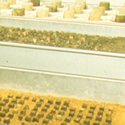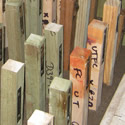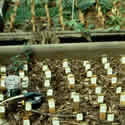Laboratory Soil Bed Tests
This method describes a procedure useful for the evaluation of the efficacy of wood preservative formulations in soil contact. The procedure has historically been described by the terms fungus cellar, soil bed facility for accelerated biodeterioration or accelerated field simulator.
In the scope of this method, fungal cellar and field simulator are considered to be too restrictive as descriptors. Soil bed is the preferred terminology. In its most basic form the soil bed exposes treated and untreated wood samples to wood destroying organisms in bins of unsterile soil maintained in conditions designed to accelerate the decay effect. Samples are inspected periodically to determine the extent of decay present. The strength of the technique lies in the fact that the performance of new preservative formulations is compared to that of preservatives known to be effective under the same conditions. Through manipulation of environmental conditions a soil bed can be used as an accelerated, unsterile soil, soft-rot test or an accelerated field simulator encompassing the broad range of biological decay types including soft-rot and basidiomycetes found in a natural, outdoor soil exposure.
One standardized version of this method is available as AWPA Standard E14. The European Standard for the soil bed test method is ENV 807.
Images
References


